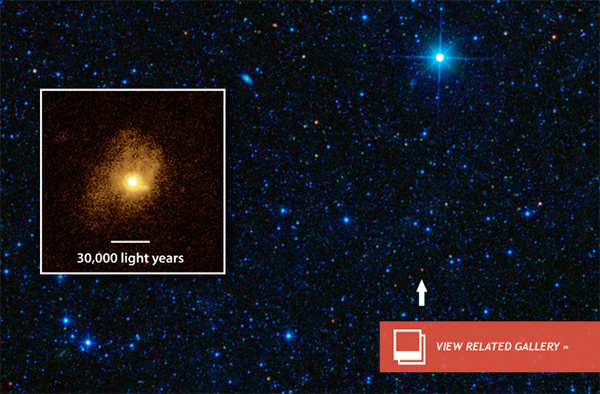'Green' Galaxy Recycles Gas, Supercharges Star Birth
In a galaxy, far, far away (6 billion light-years away to be precise), the most efficient star “factory” has been discovered — a galaxy that recycles 100 percent of its gas into a highly efficient star-forming region at its center.
The galaxy, called SDSSJ1506+54, was discovered by the decommissioned NASA Wide-field Infrared Survey Explorer (WISE). WISE, that surveyed the infrared Universe from 2009 to 2011, noted that the galaxy was generating huge quantities of infrared radiation. Intrigued, astronomers investigated the galaxy with the Hubble Space Telescope and ground-based observatories. SDSSJ1506+54 is pumping out a thousand billion times the energy of our sun, a factor that instantly promoted the galaxy to “most efficient” in the Galaxy Green League.
“This galaxy is remarkably efficient,” said lead scientist Jim Geach of McGill University in a NASA news release. “It’s converting its gas supply into new stars at the maximum rate thought possible.”
Usually, like our not-so-environmentally conscious galaxy, star formation occurs in clumps, where large clouds of gas collect along spiral galaxies’ elegant spiral arms. This leaves a lot of gaseous leftovers that are strewn throughout interstellar space that may never be used to birth stars.
'Green' Galaxy Recycles Gas, Supercharges Star Birth
It appears SDSSJ1506+54 is different; it has a mechanism that funnels all the available gas throughout the galactic structure into the galactic core, where a maelstrom of star formation is constantly being fed. In effect, it has optimized its production line, using all available gas for the construction of stars. There appears to be little wasted in this supercharged galaxy.
“We are seeing a rare phase of evolution that is the most extreme — and most efficient — yet observed,” said Geach.
“While this galaxy is forming stars at a rate hundreds of times faster than our Milky Way galaxy, the sharp vision of Hubble revealed that the majority of the galaxy’s starlight is being emitted by a region with a diameter just a few percent that of the Milky Way,” he added.
The galaxy, that is located 6 billion light-years away, is very compact, measuring only 30,000 light-years across. But as follow-up observations by Hubble confirm, the intense star-forming ‘factory’ is only a few hundred light-years wide. It seems hard to imagine how the incredibly dense, bright region must look to a hypothetical alien race — to any planet orbiting the outskirts of that galaxy will likely have a “night” sky brighter than the “day.”
So the galaxy is bright and forming stars at a fast rate, how do astronomers really know SDSSJ1506+54 is a good recycler? Using the French IRAM Plateau de Bure Interferometer, the ground-based observatory was able to detect the presence of carbon monoxide inside the galaxy. CO is a known tracer for the presence of hydrogen — the ultimate fuel for star-forming regions. By calculating the rate of star formation from WISE data and estimating the total mass of hydrogen gas, the incredible efficiency of SDSSJ1506+54 became apparent — it’s forming stars at the maximum possible rate, using all available fuel reserves.
Star birthing is a delicate business. As massive clouds of gas collapse under mutual gravity and ignite protostars, the intense radiation from these stellar newborns blow the remaining gas away, stifling star formation. This process controls the theoretical maximum of star formation for any given region, but it turns out that to explain SDSSJ1506+54, it must be just the right density to balance star formation while utilizing the majority of available gas.
“We see some gas outflowing from this galaxy at millions of miles per hour, and this gas may have been blown away by the powerful radiation from the newly formed stars,” said co-author Ryan Hickox, of Dartmouth College, Hanover, N.H.
Astronomers believe that this unique galaxy was likely the result of a galactic merger — when two or more galaxies attract and merge as one. This highly efficient star forming phase may only be a very short period in the evolution of the galaxy. If this is the case, SDSSJ1506+54 has given us an insight to a wonderfully rare event in the life cycle of galaxies.
The study has been accepted for publication in Astrophysical Journal Letters.(Apr 23, 2013 12:26 PM ET // by Ian O'Neill)












